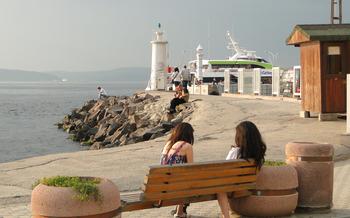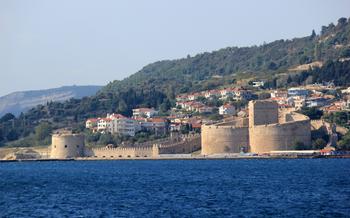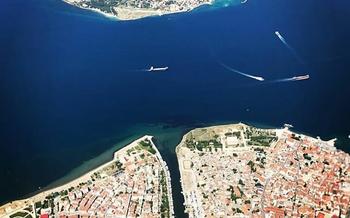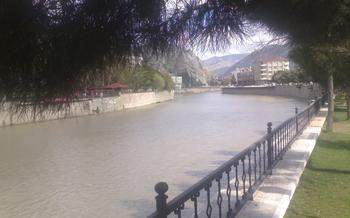
Marmaris Castle Museum
- Marmaris Castle Museum: A Journey Through History
- Exploring the Fortified Walls
- Unveiling the History of Marmaris
- Admire the Architectural Masterpiece
- Discover the Archaeological Treasures
- Step into the Ethnographic Section
- Experience the Naval History Exhibit
- Learn About the Castle's Role in World War I
- Guided Tours and Audio Guides
- Photography and Videography Guidelines
- Admission Fees and Hours of Operation
- Accessibility for Visitors with Disabilities
- Insider Tip: Discover the Hidden Gem
Marmaris Castle Museum: A Journey Through History
A journey to Marmaris Castle Museum is a journey through the annals of time, where history unfolds within the walls of this ancient fortress. Once a pivotal stronghold defending the shores of Marmaris Bay, the castle now stands as a testament to the region's rich and storied past. Its strategic location, commanding views of the Aegean Sea, made it a coveted prize throughout the ages, contested by various civilizations that left their indelible mark on the castle's architecture and legacy.
Historical significance
Marmaris Castle, built in the 16th century by the Ottoman Empire, has witnessed the rise and fall of civilizations. It played a crucial role in protecting the region from invaders, serving as a military base and a strategic defense point. The castle's strategic importance continued into the 20th century, when it became a vital Allied base during World War I.
Architectural features
The castle's architecture is a testament to its diverse history. Constructed with local stone and featuring impressive fortifications, it showcases a blend of Byzantine, Ottoman, and Rhodian influences. The castle's imposing walls, towers, and bastions stand as a testament to the engineering skill of its builders.
Museum exhibits
Today, Marmaris Castle has been transformed into a captivating museum, showcasing a remarkable collection of artifacts that narrate the region's fascinating history. From ancient pottery and coins to traditional costumes and maritime equipment, the exhibits offer a glimpse into the diverse cultural heritage of Marmaris.
Location and accessibility
Located in the heart of Marmaris, the castle museum is easily accessible. Situated on the waterfront, it offers breathtaking views of the harbor and the surrounding landscape. The museum's convenient location makes it a must-visit destination for anyone seeking to delve into the rich history and cultural heritage of Marmaris.
Exploring the Fortified Walls
The fortified walls of Marmaris Castle stand as a testament to the castle's defensive capabilities and strategic importance. Constructed with precision and resilience, these walls once served as an impenetrable barrier against invaders.
As you ascend the castle's ramparts, you'll be greeted by breathtaking panoramic views of Marmaris and its picturesque surroundings. The glistening turquoise waters of the Mediterranean Sea stretch out before you, dotted with sailboats and fishing vessels. The lush green forests that hug the coastline provide a vibrant contrast to the azure hues of the sea.
Beyond their defensive function, the castle walls also hold significant historical value. Each stone bears witness to the battles and sieges that shaped Marmaris' past. The scars left by cannonballs and the remnants of ancient fortifications tell tales of courage, resilience, and the indomitable spirit of the castle's defenders.
In recent years, extensive restoration efforts have been undertaken to preserve the fortified walls and ensure their longevity. These efforts have involved meticulous repairs, reinforcement of crumbling sections, and the restoration of watchtowers and battlements. As a result, visitors can now safely explore the walls and immerse themselves in the castle's rich history, while appreciating the stunning views and the architectural prowess of its builders.
Unveiling the History of Marmaris
Marmaris, a captivating town on the Turkish Riviera, boasts a rich and diverse history that spans millennia. Its strategic location on the Aegean Sea has made it a crossroads of civilizations, leaving behind a captivating tapestry of cultural influences.
The ancient origins of Marmaris date back to the 6th century BC when it was known as Physkos, a prosperous port city under the rule of the Carian Kingdom. During the Hellenistic period, it came under the sway of Alexander the Great and his successors, who renamed it Marmaris. The city flourished as a trade center, connecting the Aegean with the Mediterranean and beyond.
In the 15th century, Marmaris fell under the control of the Ottoman Empire, which recognized its strategic importance and transformed it into a naval base. The Ottomans constructed the imposing Marmaris Castle, which served as the linchpin of their maritime defense system. Marmaris played a crucial role in the empire's naval campaigns, protecting its shores from enemy incursions.
Throughout history, Marmaris has been a melting pot of cultures, blending Greek, Roman, Byzantine, and Ottoman influences. Its rich heritage is reflected in its architecture, cuisine, and traditions, creating a vibrant and cosmopolitan atmosphere.
Admire the Architectural Masterpiece
The Marmaris Castle stands as a testament to the region's rich architectural heritage. Its unique design, blending elements of Byzantine, Ottoman, and Seljuk styles, reflects the diverse influences that have shaped Marmaris throughout history. The castle's towering walls, intricately carved gateways, and elegant arches showcase the craftsmanship and artistry of past generations.
As you wander through the castle's chambers, marvel at the intricate tilework that adorns the walls and the beautifully preserved frescoes that depict scenes from Turkish history and mythology. Each room offers a glimpse into the castle's past as a fortress, a residence, and a center of administration.
The Marmaris Castle is not merely a historical monument but also a symbol of the town's identity. Its imposing presence dominates the harbor, serving as a reminder of the town's enduring spirit and resilience. Preservation efforts have been undertaken to ensure that this architectural masterpiece continues to stand as a symbol of Marmaris' proud heritage.
Discover the Archaeological Treasures
Delve into the depths of Marmaris' rich history through its archaeological treasures, meticulously displayed within the museum's walls. Unearth ancient artifacts that narrate the story of civilizations that once flourished in this region. Marvel at the intricate pottery and ceramics, each piece a testament to the artistry and craftsmanship of bygone eras. Admire the collection of coins and jewelry, offering glimpses into the economic and social structures of the past. These precious artifacts provide a tangible connection to the lives and cultures that shaped Marmaris into the vibrant city it is today, granting visitors a deeper understanding of its enduring legacy.
Step into the Ethnographic Section
The ethnographic section of the Marmaris Castle Museum is a fascinating journey into the region's rich cultural heritage. Here, visitors can delve into the traditional way of life that shaped Marmaris' unique identity.
Exhibits in this section showcase traditional costumes, each intricately embroidered and reflecting the region's distinct style. Visitors can admire the skillful craftsmanship and vibrant colors that adorn these garments, gaining insights into the local fashion and cultural practices.
Beyond costumes, the ethnographic section also features displays of local handicrafts that reflect the region's artistic traditions. From handwoven textiles to intricate pottery, these exhibits showcase the creativity and artistry of Marmaris' people. Visitors can appreciate the delicate details and unique designs that make each piece a true work of art.
Another highlight of the ethnographic section is the collection of exhibits that depict the rural lifestyle of Marmaris. Visitors can learn about traditional farming practices, animal husbandry, and the tools and equipment used in daily life. These exhibits provide a glimpse into the challenges and rewards of life in rural Turkey, showcasing the resilience and ingenuity of the local people.
Through these captivating exhibits, the ethnographic section of the Marmaris Castle Museum preserves and celebrates the region's cultural heritage. It allows visitors to connect with the past, appreciate the traditions that have shaped Marmaris' identity, and gain a deeper understanding of the local way of life.
Experience the Naval History Exhibit
Delve into the maritime prowess of Marmaris at the Naval History Exhibit. Gaze upon intricate model ships, meticulously crafted to replicate vessels that once sailed these very waters. Examine authentic maritime equipment, offering a tangible connection to the region's seafaring past. Learn about Marmaris' crucial role in naval battles, contributing to the rich tapestry of Turkish naval history. Discover the stories of brave sailors and their epic voyages, showcasing the indomitable spirit of this coastal town.
Learn About the Castle's Role in World War I
During World War I, Marmaris Castle played a crucial role due to its strategic location and the presence of a significant naval base. In 1915, the Allied forces, including British, French, and Italian naval vessels, occupied Marmaris as part of their operations against the Ottoman Empire. The castle served as a strategic base for the Allied forces, who used it to launch attacks against Ottoman positions and to control the movement of ships in the Aegean Sea.
The castle witnessed intense battles and conflicts during the war, as the Ottoman forces attempted to retake the town and the castle from the Allied forces. The castle's fortifications and defensive structures proved to be effective in repelling Ottoman attacks, and the Allies maintained control of Marmaris until the end of the war.
The castle's involvement in World War I had a significant impact on Marmaris' history. The town and the castle suffered some damage during the war, but the castle's resilience and strategic importance were reinforced. The role of Marmaris Castle in World War I is commemorated in the museum's exhibits and displays, providing visitors with a glimpse into this turbulent period of the castle's history.
Guided Tours and Audio Guides
To enhance your visit to the Marmaris Castle Museum, guided tours are available in various languages, providing informative insights and historical context. These tours offer a deeper understanding of the castle's significance and the stories behind its exhibits. For a more independent exploration, audio guides are also available, allowing you to delve into the museum's treasures at your own pace. With these options, you can tailor your experience to suit your preferences and make the most of your time at the Marmaris Castle Museum.
Photography and Videography Guidelines
The Marmaris Castle Museum welcomes photography and videography enthusiasts to capture the beauty and history of the castle and its exhibits. However, to ensure the preservation of the artifacts and the comfort of other visitors, certain guidelines must be followed.
Photography and videography are permitted in most areas of the museum, except for those where explicitly prohibited by signs or museum staff. The use of flash photography is generally discouraged to avoid damaging delicate artifacts. Visitors are encouraged to be respectful of other guests and avoid blocking their views or interrupting their experience.
The museum's staff is available to assist visitors with any photography-related questions or concerns. By adhering to these guidelines, visitors can capture their memories of the Marmaris Castle Museum while respecting the integrity of this historic site.
Admission Fees and Hours of Operation
Visiting the Marmaris Castle Museum is a cost-effective way to explore the town's rich history and culture. Ticket prices are reasonable, with concessions available for students and children. It's advisable to check the museum's website or contact them directly for the most up-to-date information on admission fees and any special discounts or offers.
The museum follows specific opening and closing hours to ensure the preservation of its exhibits and the well-being of its staff. Planning your visit accordingly is crucial to avoid disappointment. The museum typically operates daily, with extended hours during the peak tourist season. It's always best to check the museum's website or contact them to confirm the exact hours of operation before your visit.
By planning your visit effectively, you can make the most of your time at the Marmaris Castle Museum. Whether you're a history buff, an art enthusiast, or simply curious about the town's heritage, the museum offers a captivating journey that will leave a lasting impression.
Accessibility for Visitors with Disabilities
The Marmaris Castle Museum recognizes the importance of accessibility for all visitors, and has taken steps to ensure that individuals with disabilities can fully experience the museum's offerings. The museum is wheelchair accessible, with ramps and elevators providing easy access to all floors and exhibits. Designated parking spaces for visitors with disabilities are available near the museum entrance, ensuring a convenient and stress-free arrival. Additionally, the museum staff is trained to assist visitors with special needs, providing any necessary assistance to make their visit enjoyable and informative. By embracing inclusivity, the Marmaris Castle Museum strives to create a welcoming environment where everyone can delve into the rich history and cultural heritage of the region.
Insider Tip: Discover the Hidden Gem
Beyond the main exhibits, Marmaris Castle Museum holds a secret that awaits curious visitors. A hidden passage leads to a concealed room, revealing a lesser-known chapter of the castle's history. While exploring the museum, keep an eye out for clues that might guide you to this hidden gem. Uncover the secrets of the castle's past and gain a deeper understanding of its significance. This hidden room offers a unique and memorable experience, allowing you to explore beyond the ordinary and delve into the depths of Marmaris' rich heritage.









